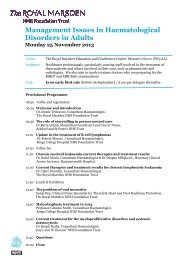Central Venous Access Devices - The Royal Marsden
Central Venous Access Devices - The Royal Marsden
Central Venous Access Devices - The Royal Marsden
Create successful ePaper yourself
Turn your PDF publications into a flip-book with our unique Google optimized e-Paper software.
<strong>Central</strong> venous access devicesIntroductionSome of the treatment you require will need to be given directly intoyour bloodstream. In order to do this, we will place a device intoyour vein, called a venous access device. This enables us to haveaccess to your venous system to give your therapy.<strong>The</strong>re are several different types of devices available. One type iscalled a peripheral cannula. It is a small plastic tube that is insertedinto a vein in your lower arm or hand, through a needle. This needleis then removed, leaving the cannula in place for a few hours or upto three days while you have treatment. We will remove the cannulawhen you finish treatment. You will be given a new cannula everytime you need treatment.Sometimes, this can affect the veins and make it harder to insert thecannula into a vein. If this happens it may be suggested that youhave a central venous access device put in instead. Some treatmentdrugs cannot be given into the veins of the hand or the arm and canonly be given, through a central venous access device, into a largervein leading to your heart.What is a central venous access device (CVAD)?A central venous access device (CVAD) is made of a non-irritantmaterial, for example, silicone, which means it can be left in placefor several weeks or months. <strong>The</strong> CVAD may contain one or twotubes. When a CVAD contains two tubes, it is called a double ordual lumen catheter.What are the advantages of having a central venousaccess device?Whatever the type of CVAD, it can be used to give you fluids anddrugs. It may also be used to take blood samples. <strong>The</strong> CVAD willsave you or your child from having repeated needle pricks fromblood taking or insertion of cannulas during treatment.1
















